

Marketing automation workflows are a lifesaver for time-strapped teams. Not only this, but they can also enable marketers to build better customer relationships, boost conversions, and dramatically increase revenue. To ensure your business reaps the benefits, here are 10 marketing automation workflow examples and details on how to set up your own.
So, you’ve already got a grasp of what marketing automation is, and you’re itching to get started. But wait — what are the best marketing automation workflows to try and how exactly do they work?
Below you’ll find 10 examples of marketing automation workflows, along with how they can help your business and instructions for setting them up. The workflows are separated into the following categories, based on what you’re looking to achieve:
But first, let’s go over some key terminology…
Understanding Marketing Automation Workflows
What is workflow automation?
Workflow automation is the use of technology to automate manual tasks based on a set of rules or conditions. These workflows have an “if/then” structure, meaning if a certain condition is fulfilled then an action will occur.
In a marketing context, an automated workflow involves the following elements:
- Different touchpoints in the customer lifecycle, such as when they visit your website or contact your customer service
- The conditions or triggers for steps within the workflow, which may be a customer characteristic or behavior
- The actions automatically triggered by such conditions, like sending a subscriber an email or adding them to a list
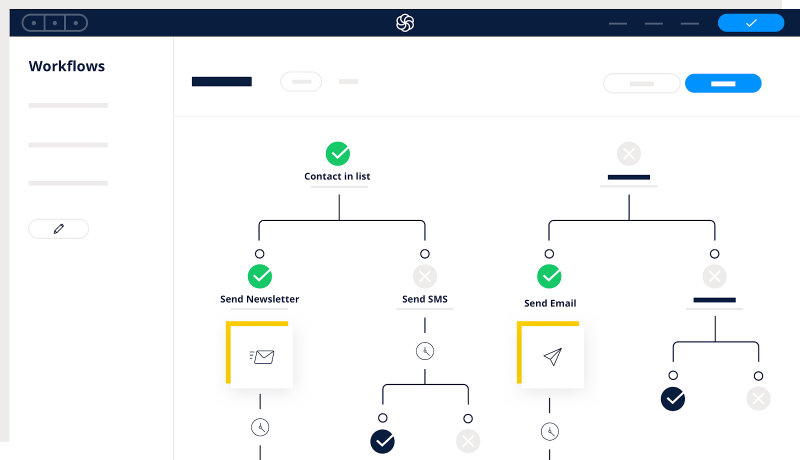
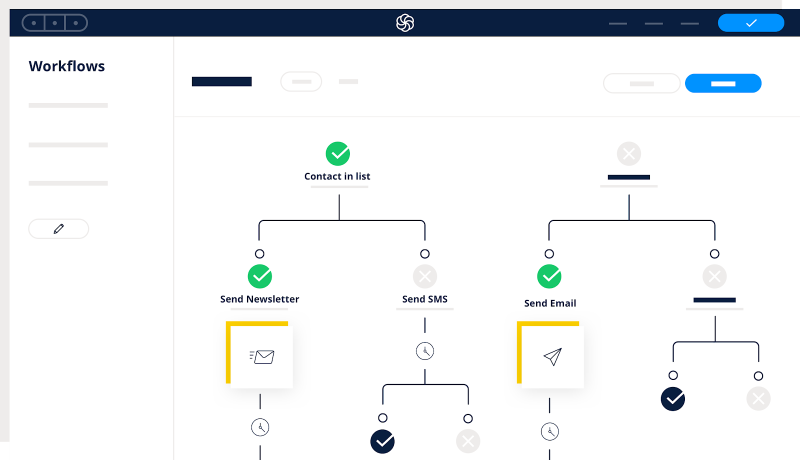
If this all sounds a bit complicated not to worry. Sendinblue’s marketing automation software offers a range of ready-to-use workflow templates for common scenarios.
So, no need to start from scratch!
Plus you can give it a try for free, with access to Sendinblue’s full suite of marketing automation features for up to 2,000 contacts on the Free plan.
Now, let’s explore some of the best marketing automation workflows and how you can put them into practice.
10 Marketing Automation Workflows and How to Set Them Up
Here are some examples of how your marketing team can use automated workflows to boost your results.
Workflows for building relationships
Automation can play a crucial role in your relationship marketing strategy. It not only helps you to secure new customers but also to ensure they remain loyal to your brand in the long term.
1. Welcoming subscribers
An effective welcome email is a must for subscribers who sign up to content like your newsletter. This simple email automation example shows your audience you care and lays the foundation for a lasting relationship.
You can use welcome workflows to:
- Re-state (or elaborate on) your value proposition. What makes you special?
- Set expectations for your subscribers. What can they expect to gain from your content and how often will they receive it?
- Welcome new subscribers to your community and give them a taste of your charming personality!
- Surprise subscribers with a bonus. This could be a coupon if you have a store or a bonus piece of content that they can download immediately.
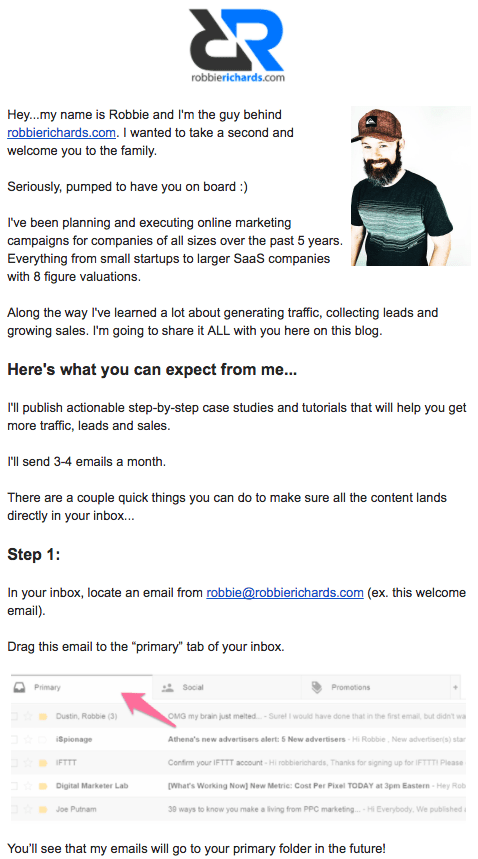

How to set up the workflow
This workflow is a type of email autoresponder. It’s among the more straightforward examples, with fewer variables and conditions involved. So, the perfect workflow for those just getting started with marketing automation!
The trigger is the submission of a signup form on your website, which adds the subscriber to your chosen list. Once they join the list this automatically initiates the workflow and sends the welcome email campaign you have prepared.
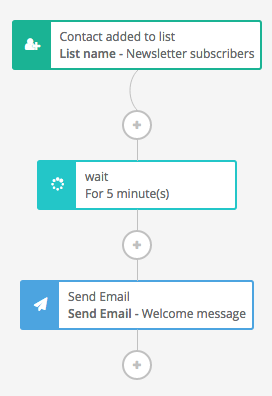

For more detail, read our tutorial on creating welcome workflows with Sendinblue
2. Offering gated content
Lead generation is never a one-way street. If you want information from your prospective customers, you need to give them a reason to share it!
Gated content is one of the best ways to achieve this. You provide something valuable to users, such as a downloadable ebook or a webinar. And in exchange they provide useful information like their name, company, email address, and other contact details.
Gated content is particularly effective as a lead generation tactic because it attracts people who are likely to be interested in your offer. A well-crafted automation workflow can help capitalize on this.
After automatically sending subscribers the content they signed up for, you can nurture leads by following up with more content tailored to their interests.
How to set up the workflow
Your starting point is to create a popup or landing page for your gated content that is connected to your database. When someone fills out the form to access the content, they are added to an email list. This initiates the workflow.
From there you can create a series of actions so that subscribers receive relevant content at the right time.
3. Lead nurturing
As the above example demonstrates, marketing automation can make nurturing new leads easier and more effective.
The goal of lead nurturing is to guide potential customers toward conversion. You could use this type of workflow to:
- Maintain customer engagement throughout their research and shopping process
- Provide prospects with the relevant information they need to make a purchase
How to set up the workflow
Your lead nurturing workflow should start at the earliest possible point in the sales funnel. This might be when someone subscribes to your newsletter or requests a demo of your product.
Once a lead enters your workflow you can track their engagement to further tailor the customer journey. For example, depending on which pages they visit on your site, you can follow up with an automated email campaign with relevant content based on their interests.
4. Getting Feedback
Customer feedback is a valuable tool not only for improving your service or product but also for building trust. And with an automated workflow collecting feedback and gauging customer satisfaction is much easier!
How to set up the workflow
First decide the touchpoint that should trigger a request for feedback. Some possible scenarios include a product purchase or a customer’s interaction with your support team. This should prompt a message asking the customer for feedback on their experience.
And you can go even further with a multi-step workflow, based on the customer’s response. For example:
- With satisfied customers, add them to a loyal customers list where you send them exclusive offers and discounts to keep them coming back for more. Another option is to take the opportunity to request a review from the customer so you can share their positive feedback more widely.
- With unhappy customers, send a personal thank you message for their honest feedback and try to learn more about their negative experience. You could also offer refunds or discounts to try and remedy the situation from a customer service perspective.
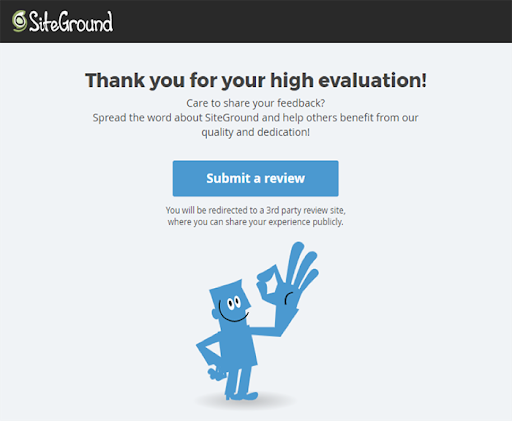
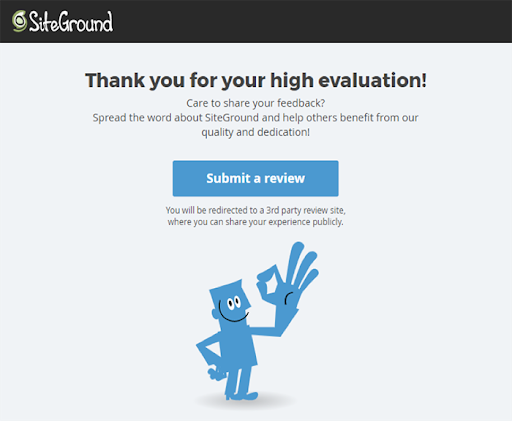
Workflows for improving engagement
Once someone subscribes or becomes a paying customer, you still need to work hard to sustain their interest and stop them from falling through the cracks. These marketing automation workflows will help you do just that!
5. Onboarding series
Onboarding emails are an important tool for ensuring customers stick with your company. You can send these automated emails following an account creation or after a customer purchases your product or service.
When a user creates an account on a website, there are usually several steps they must take to complete their profile. There are also things they must learn to be able to get the most out of their account. Your onboarding series can address some of these issues for a smoother customer experience.
In the longer term this can have benefits such as:
- Increasing customers’ engagement with your products or services and improving retention
- Identifying low-engagement users or those who have not properly set up their account for further outreach campaigns
How to set up the workflow
When a user signs up or makes a purchase, they submit a form that adds their details to your database. This action sets the rest of the workflow into motion.
Once the user receives your initial email, you can include a condition that sends a follow-up message if they have not completed the required steps after a certain amount of time.
And if they have completed their profile, you can send them a final email that shows them how to get the most out of their account.
Optimizing your email timing and monitoring whether recipients completed the last key action is essential. This ensures users receive value from your onboarding emails and reinforces that your brand is there to help.
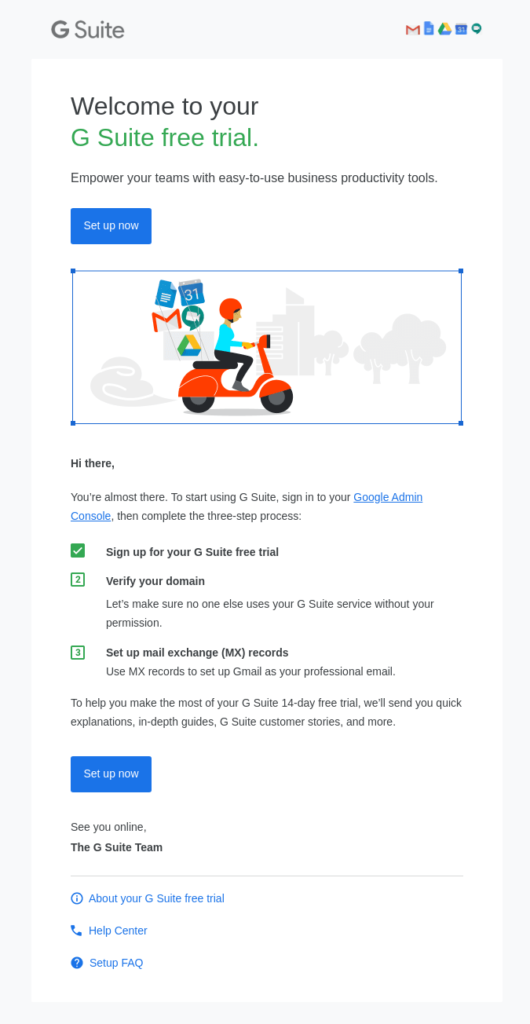
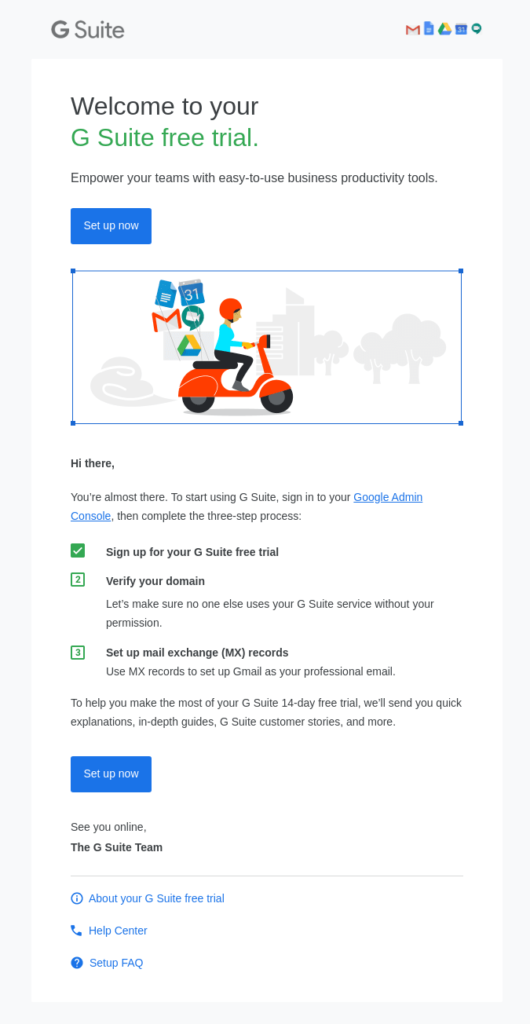
6. Celebrating birthdays or anniversaries
Give your customers the VIP treatment by automatically sending them a special discount for their birthday or the anniversary of when they became a customer.
Personalized campaigns like this are a great way to build loyalty and keep your brand top of mind. Plus they give customers an incentive to buy from your company again or maintain their subscription.
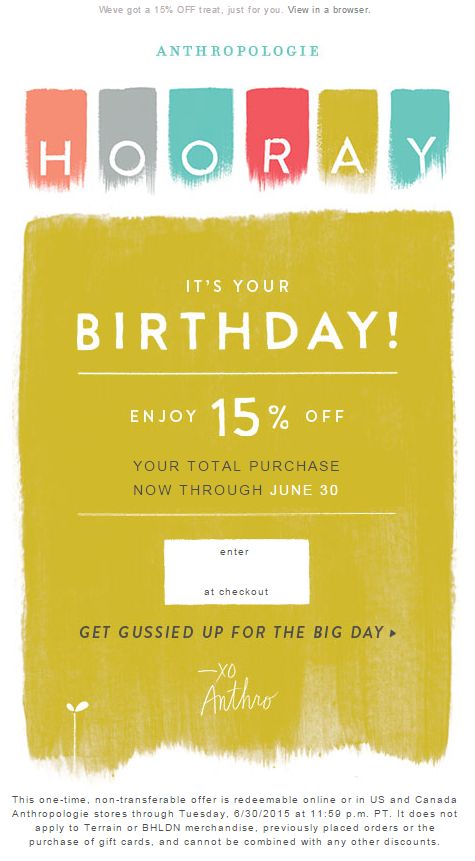

How to set up the workflow
This is one of the simplest examples to get started with automated email workflows.
For birthday messages you’ll need to ask users for their date of birth during sign up. For other scenarios you can use the date a contact was added to a particular list.
Using this contact data you can then create a workflow that automatically sends a pre-prepared message to subscribers on the same date each year.
If the customer doesn’t redeem their promotion, you could also trigger a reminder to be sent after a certain period of time.
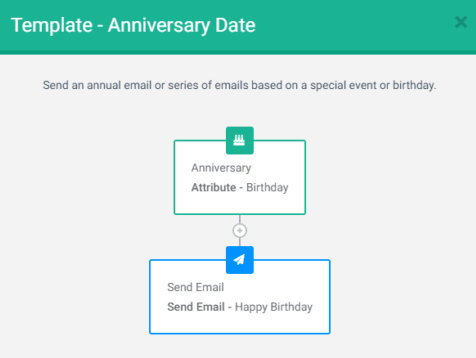
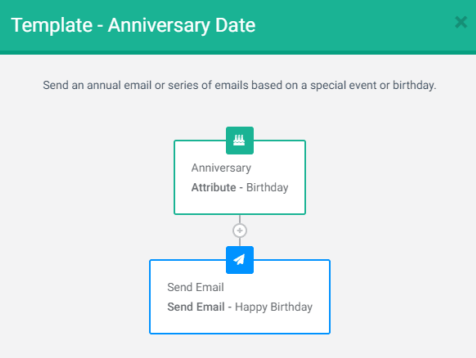
To learn how to set up a birthday email workflow with Sendinblue, as well as best practices for your email design and content, check out our guide to birthday emails.
7. Re-engaging subscribers
If you want to combat low engagement with your content or product, a re-engagement workflow is the way to go.
There are a variety of possible scenarios for this, such as:
- Asking email subscribers with poor engagement if they still want to hear from you
- Luring back a customer who hasn’t bought in a while with a discount
- Reaching out to users who haven’t logged in or used your product in a while
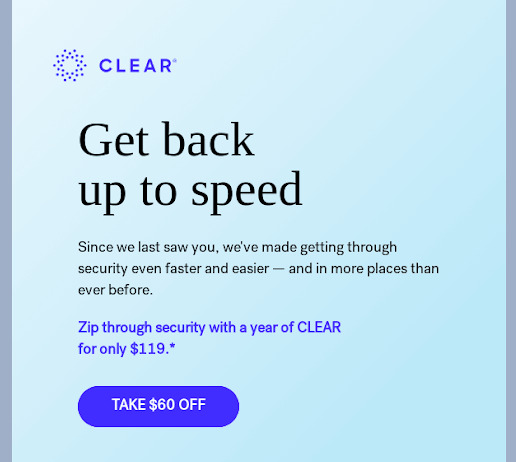
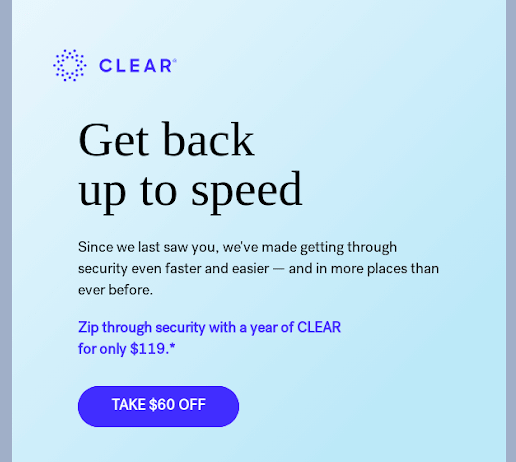
How to set up the workflow
The first step is to define an inactive subscriber and thus the conditions for a contact to enter the workflow. This might be a subscriber who hasn’t opened your emails or bought something for a certain period of time. This then triggers either a single message or a series of emails that aim to win them back.
Bonus tip: you can also use re-engagement emails to clean your list of contacts who are no longer interested. Add a step to your workflow so that if a contact doesn’t engage with your “last chance” message asking them to re-opt in, they are automatically removed from your list.
For information on how to send automated re-engagement emails with Sendinblue, along with examples to inspire you, check out our guide to reactivations emails.
Workflows for increasing revenue
With the right workflow, marketing automation can do wonders for boosting your sales. Here are some examples of exactly how you can put this into practice.
8. Following-up abandoned carts
Abandoned cart workflows are a must for any ecommerce site. Why? Put simply, by giving customers a nudge you can secure more sales and boost your conversion rate.
Abandoned cart follow-ups generally involve a message reminding a shopper about items left in their online cart, along with a link to take them back to complete their purchase.
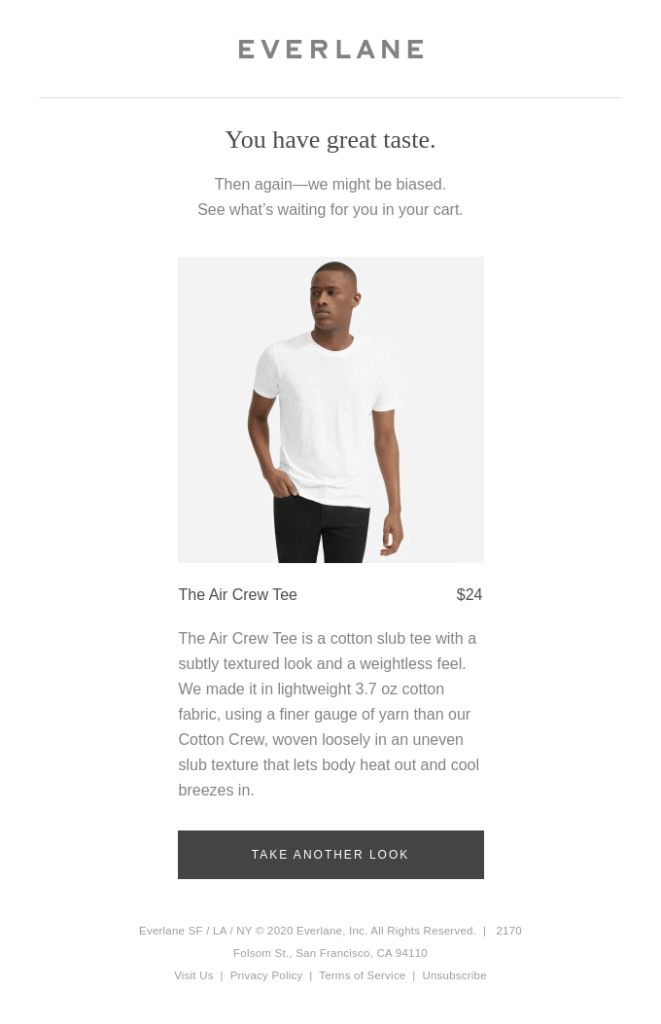

Aside from this basic format, where possible your message should address issues that may have led to the cart abandonment. For example, you could offer the shopper a discount or provide details for contacting your customer service.
Further reading: Abandoned Cart Email Examples & Best Practices to Recover Lost Sales
How to set up the workflow
The trigger for this workflow is based on shoppers’ activity on your website, specifically when they add one or more items to their cart. After a contact enters the workflow, have it wait a certain period of time (24 hours is usually sufficient). Once the waiting period is over, the workflow should check to see if the purchase was completed. If this is not the case it will automatically send your abandoned cart message.


For more detail on setting up this workflow using Sendinblue, check out our step-by-step guide to abandoned cart emails.
9. Upselling/cross-selling
Even if a customer completes their purchase first time you can still take the opportunity to boost revenue using marketing automation. Use purchase history to give relevant recommendations, such as complementary products or items popular with the rest of your customers.
This workflow is particularly effective for encouraging new customers to buy again. Not only can it increase revenue but when done right you’ll also add value to the shopper experience, which will keep them coming back for more.
How to set up the workflow
This workflow is based on customers’ past purchases. To implement it, create a segment for customers who purchase a certain product and set your workflow to launch when a contact matches the segment conditions.
Then you can send them personalized recommendations they won’t be able to resist!


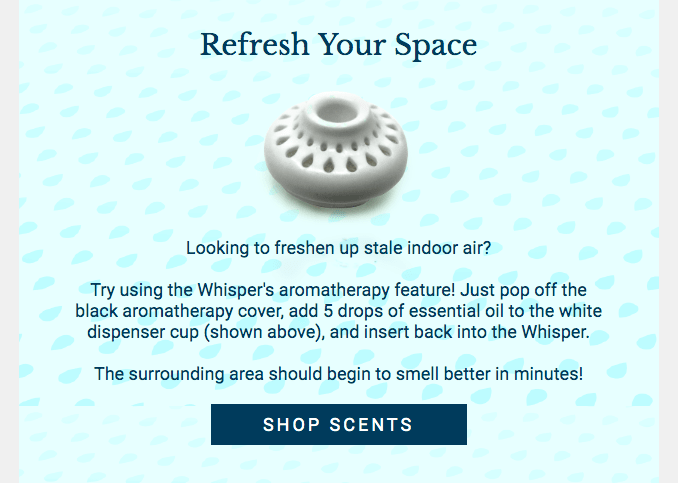

10. Lead scoring
Wouldn’t it be nice if you could know which contacts are your most promising leads and how close they are to making a purchase? With a lead scoring workflow you can do just that!
Lead scoring is exactly what it sounds like—assigning points to prospective customers based on their behavior. This helps you better target your marketing to the leads who are most likely to convert. Lead scoring can also be used for automated list segmentation based on the score of each contact.
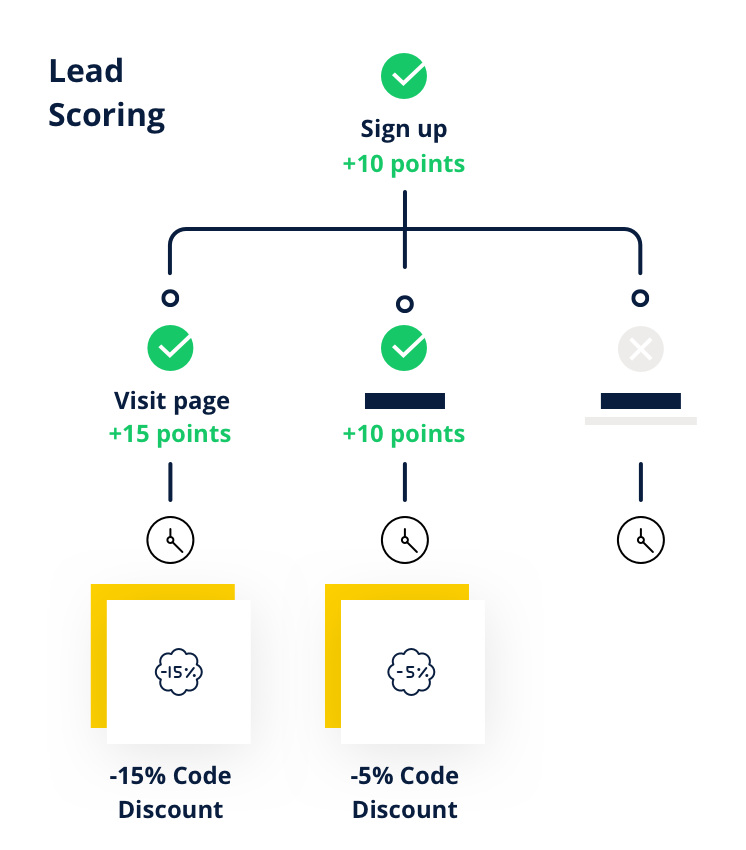
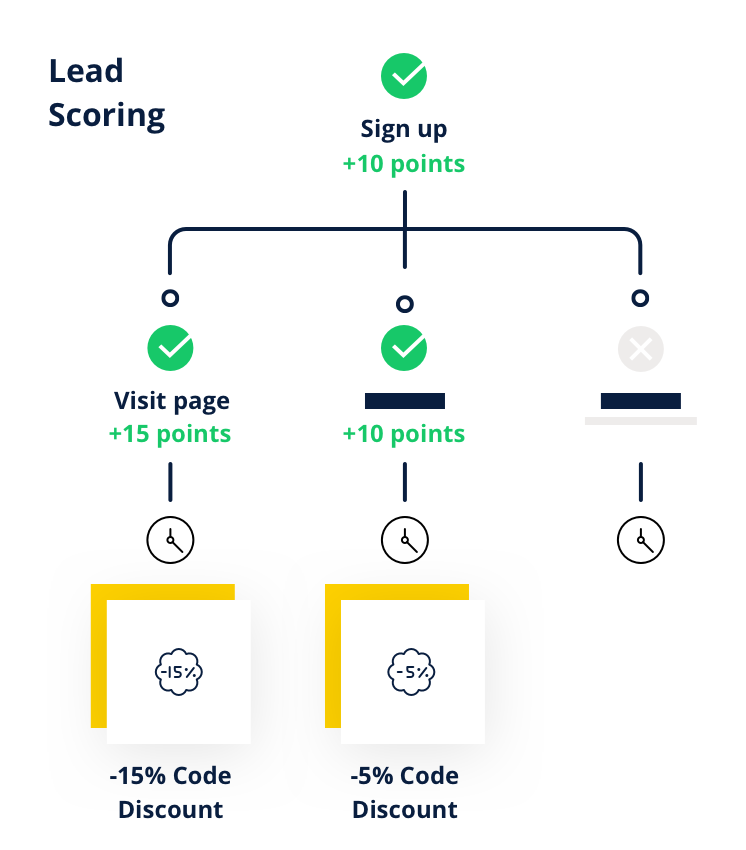
How to set up this workflow
A lead scoring workflow automatically adds points to individual contacts when they perform actions that suggest they are likely to convert.
Before starting on your workflow, you must first create a column in your customer database for “score”. This value will change based on customers’ behaviors. You will also need to determine what actions prospects generally take before converting and how many points each of these actions should be worth.
Once you’ve got the planning out the way, you can create workflows that will check whether contacts perform the various actions leading to conversion.
For more detailed instructions, read our guide on creating a lead scoring model.
Start Building Your Own Marketing Automation Workflows
Hopefully these workflow examples have whet your appetite and inspired you to put your knowledge into action! Be sure to also check out our list of marketing automation best practices for tips on getting the most from your efforts.
And if you’re looking for a solution to get started with marketing automation, why not give Sendinblue a try?
Our Free plan includes all marketing automation features and allows you to target up to 2,000 contacts in your workflows. Or, if you’re looking to scale your marketing, you can get unlimited automation on our Premium plan.
So, what are you waiting for?
 Deutsch
Deutsch




















